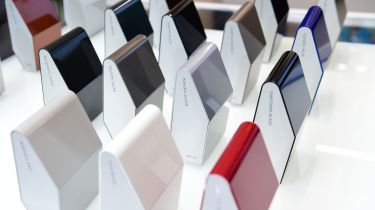Which car colour has the best resale value?
You’ve no doubt heard the adage that silver cars are easiest to sell, which is why there are so many on the roads today

You’ve no doubt heard the adage that silver cars are easiest to sell, which is why there are so many on the roads today.
While this isn’t necessarily the case, colour does play a part in how much money you’re likely to get when you eventually sell your car. The list of the most popular colours for new cars has remained largely static for several years now so buyers definitely have preferences, but a splash of a more unusual colour can also make certain models of car much more appealing for buyers.
Below, we’ve examined the most popular colours on new cars, and why so many people choose them. You can also read about which colours hold their value best, and whether you can, and should, change the colour of your car.
What are popular car colours?
Figures revealed by the Society of Motor Manufacturers and Traders (SMMT) at the beginning of 2024 showed that in 2023, for the sixth year running, the UK’s favourite new car colours were grey, black, white, blue, and red.
This probably won’t come as a surprise to anyone who has studied a supermarket car park recently, which typically has as much vibrancy as the picture on an early television, and while blue and red are still hanging on in the most popular colour lists, even those tend to be mostly darker shades.
- Grey – While battleship grey has become popular on certain models in recent years, ‘grey’ also encompasses darker metallics. The popularity of grey cars isn’t surprising – it’s the ultimate ‘safe’ choice, since most cars look pretty decent in neutral shades like grey and it’s unlikely to scare off subsequent buyers, in theory improving resale value. It also hides dirt better than black or white, and looks more expensive than white especially.
- Black – Black is another safe choice which works on all kinds of cars. It can look classy and understated, while for those who prefer cars with a more aggressive look it can have a bit of menace too, especially when combined with black exterior detailing. Black is pretty timeless as well – just as with clothing, black cars will probably never go out of fashion.
- White – White’s ascendency to popularity happened fairly suddenly. For years people would try to avoid white cars, as it looked cheap, showed off dirt worse than any other colour, and on older cars, was worst of all for showing when corrosion started to bubble through the paint. Then in the 2000s, it started to become popular on high-end SUVs and luxury cars, and that association with expensive cars began to trickle down to everything else. Now, many manufacturers will even charge you extra for some shades of white.
- Blue – Blue has always been a popular car colour, and the SMMT’s figures show it was second in popularity to silver until 2005, before slowly dropping away to its current fourth place. It’s about as adventurous as buyers will get with actual colours now, though outside of sportier models, most blues offered on new cars are somewhat subdued.
- Red – Back in the 1990s, red was the most popular car colour for several years, with a quarter of the market share. Bright scarlets and blood reds were just about everywhere, bolstered by their association with sporty models, from hot hatchbacks to Porsches and Ferraris. Today, brighter hues are difficult to find on new cars – most reds are, like their equivalent blues, typically darker garnets and maroons. Mazda breaks the trend though – its deep Soul Red is the company’s most popular colour.
What car colour holds its value best?
This is where you might be surprised, as shades like silver and black by no means guarantee the best resale value, and some studies even put them among the fastest depreciating hues. Their popularity seems to be something of a self-fulfilling prophecy, where people believe them to hold their value, so manufacturers make more of these colours, so people buy nothing else – and other shades are seen as being harder to sell by default.
Logically speaking though, if you’re trying to sell a silver car identical to 99 other silver cars on the market, then you’ve only got a 1 in 100 chance that a buyer who wants a silver car will pick yours, and may have to drop your price to encourage that buyer. However, if you’re the only person with a yellow car for sale, there’s a 100 per cent chance you’ll find that one buyer who wants a yellow car, and they may have no other choice than to pay your asking price.
This is especially the case when it comes to high-end models and sports cars, where showing off is part of the appeal, and where a rare colour can add thousands to the price of a car compared with a more common one.
While there’s no consistent leader in terms of which cars hold their value the best, bright shades like yellow, orange, and red have appeared towards the top of recent lists, perhaps pushback on the fact that most cars are now grey, black, or white. A 2021 survey by Riverdale Leasing suggested that across the market, gold cars sold for more than equivalent models in any other colour, yet another study by iSeeCars in the US came up with the exact opposite result, with gold cars depreciating the most over three years.
Ultimately, there are so many more factors at work that colour when it comes to determining a car’s value that the impact the colour has is hard to pin down. Silver or grey won’t actively harm resale then, but they won’t guarantee you the best price either, since a buyer can easily find a similar car elsewhere. Just don’t put your faith in gold.
Can I change the colour of my car?
There’s very little stopping you changing the colour of your car, provided you have the time and money to do so and inform the relevant people, such as your insurance company and the DVLA. Changing a car’s colour has become especially popular as vinyl wrapping technology has improved, giving buyers an easy and non-permanent (if still fairly expensive) way of changing their car’s appearance.
How to change a car’s colour
Full respray
This is the most in-depth, permanent, and expensive way of changing your car’s colour, and if you’re taking this step then it’s probably because you intend to keep your car for some time – it’s not something you’ll do during a two-year PCP. A respray is a popular choice when it comes to modifying or restoring a car, giving the car a whole new look. Expense will vary depending on how in-depth the work is – resprays are rarely cheap, but a quick blow-over of exterior panels will set you back less than a full bare-metal respray with several layers.
Vinyl wraps
Vinyl wrapping has been around for a while but its popularity has exploded over the last decade or so. It’s one of the easiest ways of changing your car’s colour, and while it’s not cheap – upwards of a couple of grand to do a full car – it’s still cheaper and quicker than a respray, and has the benefit of not being permanent, so if you decide you’ve made a terrible mistake and want to return your car to standard, you can just peel it all off again. The possibilities are nearly endless too, from solid colours to chromes, textured wraps, and racing car liveries.
Replacement panels
This is a less common way of changing a car’s colour, but applies to some older cars where panels are easy to remove and replace by simply bolting them on and off – sometimes for a two-tone effect. More recently, some cars from the Smart brand were designed to have swappable panels, so while the car’s central safety cell remained the same colour, you could switch out the doors, bonnet, boot lid, and wings for panels of a different hue.
Will changing my car colour impact its resale value?
Probably, but there’s no hard and fast rule to say how much a colour change might affect a car’s value, and there’s certainly no guarantee that you’ll make back what you financially put into changing a car’s colour.
One thing a colour change might achieve is getting more eyes on your car. Few people will be willing to pay extra for a car that has been wrapped in a different colour, but if that wrap helps the car stand out in a crowded market, then it might result in an easier sale.
Equally, if you’ve restored a car and had it painted in a different colour from the original, the work has been done to a high standard, and the colour suits the car, then some buyers may be prepared to pay more for it – not least because a freshly-resprayed and restored car will likely be worth more than an equivalent car where everything is looking a little tired.
You need to be careful when it comes to classic and collector cars however, as in this market, buyers can place real emphasis on originality. While a respray in the original hue should be fine, going for a non-original colour might put off buyers who’d otherwise have been queuing at your door had you stuck with the original shade. Remember, colour is a very personal thing, and what you think looks great might not work for many other people.
Frequently Asked Questions
Different surveys give different results, so there’s no hard and fast rule here. Black, silver, grey, and white are all ‘safe’ choices that won’t turn buyers away, but won’t necessarily command the best prices.
Did you know you can sell your car with Auto Express? Get the highest bid from our network of over 5,500 dealers and we'll do the rest. Click here to try Auto Express Sell My Car now...
Find a car with the experts









